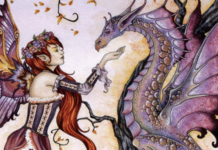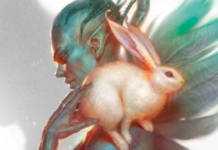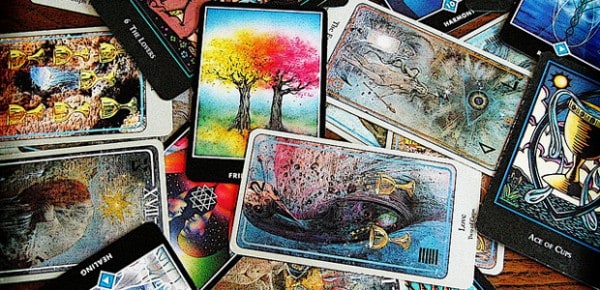 People who are interested in beginning tarot reading are often faced with a simple problem: how do you choose a deck that’s right for you? There are many schools of thought on how to be sure that you’re picking up a deck that’s right for your personal needs, but with all the options both online and out in the wild, it can be overwhelming.
People who are interested in beginning tarot reading are often faced with a simple problem: how do you choose a deck that’s right for you? There are many schools of thought on how to be sure that you’re picking up a deck that’s right for your personal needs, but with all the options both online and out in the wild, it can be overwhelming.
Many people who attempt to foster a skill in reading tarot give up because they have trouble with using their first decks. New readers can be taken by some of the gorgeous artwork they find on decks, ignoring more traditional decks only to find out all those pretty pictures mean nothing to them. Or, on the other hand, they may grab a traditional deck, and find they are completely unable to connect with it.
Asking for deck suggestions can also lead to an overwhelming amount of information and, being inexperienced, a new reader may not know whose advice to follow. These tips and information will hopefully, help new readers find a deck that works for them.
It’s better if it’s a gift, or, how to buy a tarot deck
Before we start with how to choose a deck, we need to talk about the myth of being gifted a deck. There is this saying that tarot decks shouldn’t be purchased but should be given as gifts in order for them to “really work.”
I was told this when I started, many of my friends who read tarot were told this, it seems that everyone who wants to pick up the craft hears this line. Although it is very nice to receive a tarot deck as a gift, it is not necessary. You can read just as well from a deck that you purchased yourself. A deck you paid for is not inferior to one that someone gifted to you.
This is an oft-repeated superstition, but you don’t have to wait for someone to pass down the gift of tarot for you to get started on your journey. That said, if someone wants to gift you one, never look a gift deck in the mouth.
What’s in a deck?
If you’re unfamiliar with tarot, then you may not realize that there are different types of decks. I don’t mean just in art style, of which there are hundreds, we’re speaking of the base of the deck.
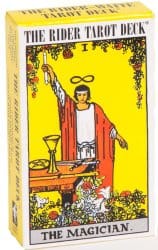 There are five basic deck types. Rider-Waite-Smith (often abbreviated to RWS), Thoth, Lenormand, oracle, and unique. When choosing a deck, it is important that it aligns with whatever source you will be learning to read from. This isn’t such a concern if you’re purchasing a book and a deck together, but it can cause major issues with your studies if your deck type and education source aren’t on the same page.
There are five basic deck types. Rider-Waite-Smith (often abbreviated to RWS), Thoth, Lenormand, oracle, and unique. When choosing a deck, it is important that it aligns with whatever source you will be learning to read from. This isn’t such a concern if you’re purchasing a book and a deck together, but it can cause major issues with your studies if your deck type and education source aren’t on the same page.
The Rider Tarot, or the RWS, is the most popular type of deck and many of the more artistic decks are based on this style in the sense of consistent order and meaning. You can find a traditional RWS deck in any store that sells metaphysical or spiritual goods as well as many variations on the theme.
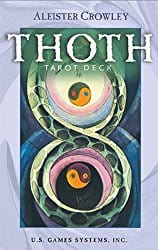 The Thoth Tarot is very similar to RWS in many ways. Although the traditional deck looks very different in art style, they share many of the same cards. It’s fairly easy to mistake a Thoth deck for a RWS deck but because the cards themselves carry slightly different meanings, and trying to apply RWS knowledge to a Thoth deck will leave you with readings that will likely be a bit off.
The Thoth Tarot is very similar to RWS in many ways. Although the traditional deck looks very different in art style, they share many of the same cards. It’s fairly easy to mistake a Thoth deck for a RWS deck but because the cards themselves carry slightly different meanings, and trying to apply RWS knowledge to a Thoth deck will leave you with readings that will likely be a bit off.
Oracle decks are not based on either of the major deck types. Instead, they are themed cards, generally featuring a single artist’s work. They come with their own books that outline the meanings behind each card. Similarly, the Lenormand Oracle is a type of card deck that is more consistent across many versions of the cards, it is it’s own distinct deck type. Although many tarot readers do work with oracle decks for personal meditation as well as clients, these are not tarot decks. You cannot learn how to read tarot using them.
Finally, there are unique decks, which is a catchall term for all those divination decks that don’t quite fit into the other three categories. Unique decks may be similar to your standard decks, however they may have far more cards included or less. They may only be the major arcana of a standard deck. They also may be a deck maker’s reinterpretation of the traditional 78 cards. These sorts of decks can be a real treat for an experienced reader or collector, however, new readers should avoid them until they have a better understanding of the cards.
If your goal is to learn to read tarot, you are probably studying in the RWS tradition. This is the most common method. The simplest way to determine the type of deck is just to look at the number of cards in the box. Both RWS and Thoth have 78 cards. If the deck you are looking at has more or less than that number, it is either an oracle or a unique deck.1
Once you’ve established the card number, do some Internet searching. Sometimes you can find information about the deck that will tell you if it’s a RWS or Thoth deck, if not, just look up the Strength card. If this card is the 11th, then it is more likely to be a Thoth-inspired deck. The secondary way is to check out the court cards, if there are Pages and Knights, it is likely a RWS, if they are Princesses and Princes instead, it is Thoth.
If a set of Thoth cards speaks to you more, you certainly can use them for your first deck, however, make sure that you are learning from a book or person that is focused on that style. If you are looking for a book to start with, you can pick up The Book of Thoth by Aleister Crowley, but that may be, admittedly a bit much for a brand new reader. It is an occult-heavy, dense work. The Thoth Companion by Michael Osiris Snuffin is a much more approachable introduction to those that are new to the craft.2
Books: Little white, and otherwise
Many decks come as sets with that include a full book that outlines, in depth, the meaning behind each card as interpreted by that deck’s maker. Most of the time these meanings are fairly standard but focused on the theme of that deck. Even if a deck does not have a fully illustrated guide, they all come with Little White Books (LWB) which are the pamphlets inside of the card boxes. LWB can be deck-specific, but tend to be fairly general and brief in regards to the cards themselves.
Excluding those sets that are marketed as “learn to read tarot,” these books should be seen as supplementary and deck specific. They will help give you an understanding of the cards but they will not give you a full education in the art. If you aren’t being taught or in a situation that will allow you to read for others fairly regularly, having another source of information, be it a website or book, will help you gain more knowledge in the craft.3
Does the art matter?
The art on a tarot deck is probably the most important aspect, it is, after all, what you see and will be interacting with. If a deck’s art completely turns you off, then that is a deck you will always struggle to read. You can get a deck that is more artistic or aligns with your style and beliefs, but you want to make sure that the classic imagery is still recognizable. This is because as a new reader, you are still trying to learn the symbols.
Another concern with art is whether or not the cards are fully illustrated or if the minor arcana are just pip cards. Pip cards feature only the suit and number. So, for example, just three cups instead of three figures drinking joyously from them, or just four swords instead four swords positioned over a fallen knight.
The images on the cards act as prompts and although an experienced tarot reader can look at five wands on a card and know that’s about strife, it may help someone who is just starting out to see the figures battling with the five wands to really cement the information in the memory.
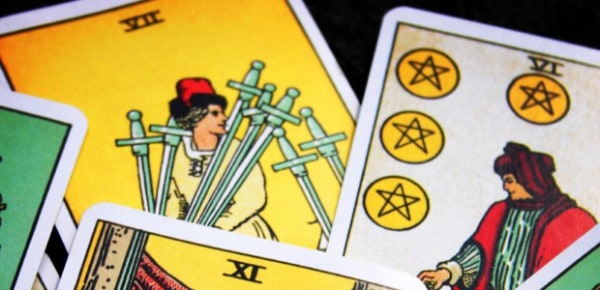
Feeling a deck
When we talk about buying a deck, there’s a lot of discussion of feeling a connection with the deck. While you should feel drawn to your cards, the truth of the matter is, you are unlikely to feel a connection with something you picked up from a store and if you do, it’s probably less psychic and more visual.
The lack of connection isn’t necessarily because you are a new reader or because it’s not possible to be connected to a set of cards, it’s because in most cases, you will not be able to actually handle the cards. In order to really get a feel for the cards, you need to be able to handle them. This is sadly impossible to do in most shopping situations because you can’t just take them out of the box and give them a shuffle.
If you do feel a connection with a deck, although it may be that it will be a strong deck for you, being a new reader you will be less likely to tell the difference between a psychic pull and just really digging the artwork. It is important to remember that artwork is designed to make us feel and even card sized pieces can touch us on an emotional level.
There are decks out there that are truly beautiful and it’s not surprising that you’d be drawn to them. Feel free to buy them; however, it is also a good idea to have a simpler deck to learn on as well. Buying two decks can be a bit costly so if you can only afford one, it might be best to wait on that stylized option.
Spiritual practice and your deck
The world of occulture is vast, and while there’s plenty of differences between us, there’s also lots of overlap in shared practices, and tarot is no exception. Though not all practitioners read tarot, there are a variety of readers who come from a variety of belief backgrounds. You could be a kitchen witch, focus your practice on sex magick, or not even be into the occult or spirituality at all and still read tarot. To that end, there are many decks that focus on specific belief systems, and appeal to many different types of people.
If you are coming from a specific spiritual place, you may feel drawn to a deck that is based in that practice. Before you buy though, it is important to consider some of the points we’ve already covered here. Belief specific decks can be really great for either self-meditation or reading for people of similar practices, but they often have many symbols and designs that are specific to the practice and can make learning a bit difficult if the goal is to be able to read from a variety of decks. That being said, using a belief specific deck can be a very effective way of helping a new reader become familiar with working with the cards.
Final thoughts
The type of deck you choose is ultimately up to you. Whether you take a friend’s advice, research for hours, or just grab one whose art you like is your decision. Any of those options can land you a deck that you love, or hate. These tips are only meant to give you, budding reader, some help in finding some direction in the colourful waters that are the ocean of tarot.
If you do find yourself unable to use the deck you picked, don’t give up! Every reader is different and the trouble may be the deck, not you. It may take a deck or two before you find one that works well for your style of learning. Keeping these tips in mind will help point you in the right direction of finding a deck to get started with and once you’re comfortable, you can branch out and explore the great wide world of tarot for yourself.
Image credits: Ricardo Rosado and Kristin Andrus
- For inspiration, check out “11 tarot and oracle decks reviewed and ranked from 2015.” [↩]
- Read Psyche’s review of The Thoth Companion. [↩]
- Also check out Psyche’s article, “Top 5 foundational books on tarot.” [↩]


